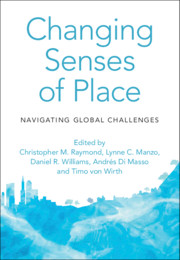Book contents
- Changing Senses of Place
- Changing Senses of Place
- Copyright page
- Dedication
- Contents
- Contributors
- Foreword
- Preface
- Acknowledgements
- Introduction
- Part I Climate Change and Ecological Regime Shifts
- Part II Migration, Mobility and Belonging
- 6 Exploring Senses of Place Through Narratives of Tourism Growth and Place Change
- 7 No One Is a Prophet at Home
- 8 Place Detachment and the Psychology of Nonbelonging
- 9 Sense of Place in Urban China
- Part III Renewable Energy Transitions
- Part IV Nationalism and Competing Territorial Claims
- Part V Urban Change
- Part VI Technological and Legal Transformations
- Part VII Design and Planning Strategies for Changing Senses of Place
- Part VIII Conclusion
- Index
- References
6 - Exploring Senses of Place Through Narratives of Tourism Growth and Place Change
The Case of the Faroe Islands
from Part II - Migration, Mobility and Belonging
Published online by Cambridge University Press: 15 July 2021
- Changing Senses of Place
- Changing Senses of Place
- Copyright page
- Dedication
- Contents
- Contributors
- Foreword
- Preface
- Acknowledgements
- Introduction
- Part I Climate Change and Ecological Regime Shifts
- Part II Migration, Mobility and Belonging
- 6 Exploring Senses of Place Through Narratives of Tourism Growth and Place Change
- 7 No One Is a Prophet at Home
- 8 Place Detachment and the Psychology of Nonbelonging
- 9 Sense of Place in Urban China
- Part III Renewable Energy Transitions
- Part IV Nationalism and Competing Territorial Claims
- Part V Urban Change
- Part VI Technological and Legal Transformations
- Part VII Design and Planning Strategies for Changing Senses of Place
- Part VIII Conclusion
- Index
- References
Summary
We explore the tensions and dynamic connections between the place narratives of Faroese residents and those of Tourism Faroe Islands. Our findings demonstrate the need to shift from sense to senses of place in order to accommodate the multiple narratives of people–place relations, which are embedded in different standpoints on mobility and place change. Residents and brokers adopt different senses of place in order to respond to social and ecological pressures wrought by mobility, and the potential economic benefits of tourism growth and development. Concurrently, important relations exist among place meanings, one’s understanding of system variability and behavioural responses. Thus, senses of place emerge as a result of dynamic and complex relationships between different types of narratives on place that are constantly unfolding in response to social-ecological change.
Keywords
- Type
- Chapter
- Information
- Changing Senses of PlaceNavigating Global Challenges, pp. 79 - 91Publisher: Cambridge University PressPrint publication year: 2021
References
- 2
- Cited by



